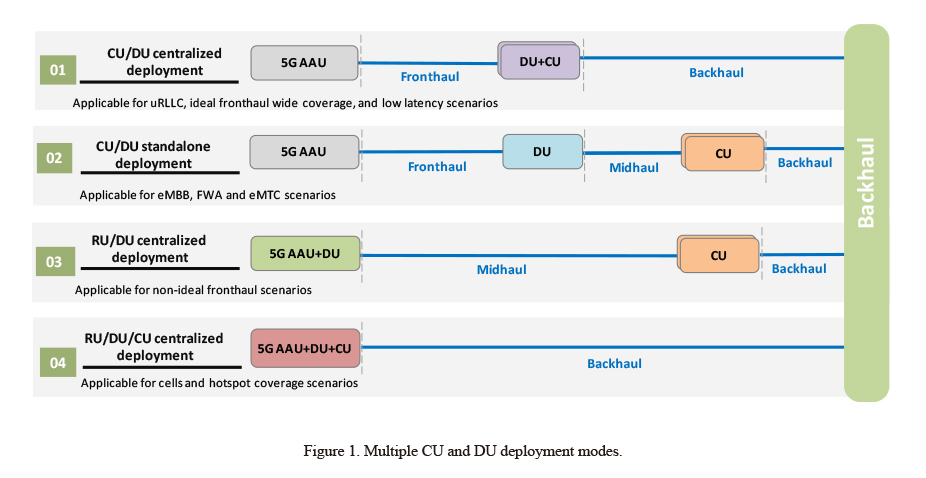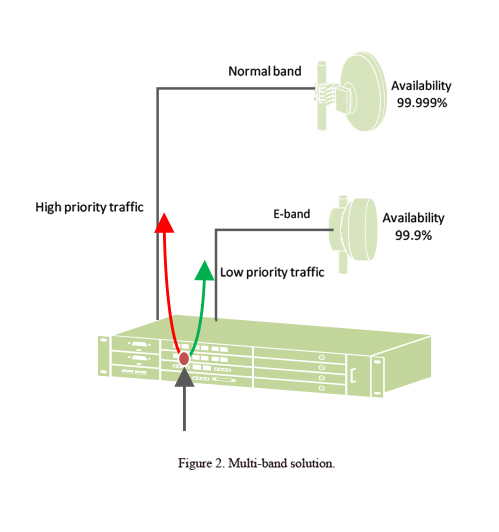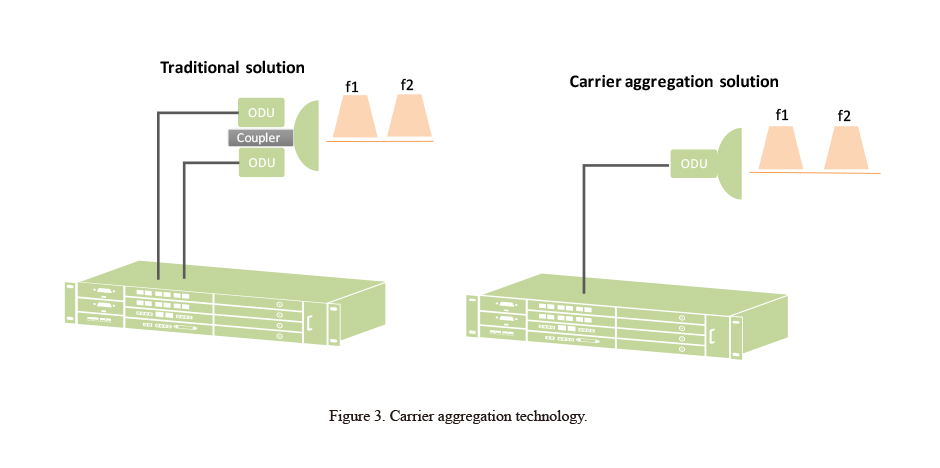Evolution Trends of 5G Microwave Backhaul Transmission
As 4G networks are widely deployed for commercial use, the fifth-generation (5G) mobile communications system for the year 2020 and beyond has become the R&D focus around the world. 5G application scenarios will cover every field of future society for intelligent man-to-man, man-to-machine, machine-to-machine interconnections. The 3GPP 5G standardization work is divided into two stages. At the first stage, the R15 standard will be released by June 2018, aiming to satisfy eMBB and uRLLC application requirements. At the second stage, the R16 standard will be released by Q4 2019 to completely satisfy the requirements of various scenarios including eMBB, uRLLC, and mMTC. By 2020, the conditions for commercial 5G deployment will fully mature. As an important transmission method for mobile backhaul, microwave boasts low cost, flexible deployment and rapid network construction, and has played a critical role in 2G, 3G and 4G network construction. However, 5G networks require enormous transmission capacity and ultra-low transmission latency, which poses greater challenges to microwave transmission devices.
5G RAN Architecture and Backhaul Requirements
5G RAN Architecture
It has been proven that C-RAN is a flexible and efficient RAN architecture for LTE networks. C-RAN can reduce the number of BBU equipment rooms, lower energy consumption, and improve spectrum efficiency and network performance. However, the traditional C-RAN uses CPRI interfaces that are difficult to offer hundreds of Gbps or even Tbps of bandwidth for 5G networks where high bandwidth and MIMO configuration are required. Therefore, a consensus has been reached in the industry that 5G RAN functional modules should be further sub-divided. According to 3GPP TR 38.801, a 5G base station will be logically split into central units (CU) and distributed units (DU). Functional modules will be flexibly configured between CU and DU, which can support either distributed or centralized base station deployment. The physical interfaces between CU and DU will adopt the Ethernet standard. In practice, the CU and DU can be deployed in multiple modes (Fig.1).

Network Cost and Energy Consumption
To meet the 5G requirement for high transmission capacity, 5G base stations are more densely deployed and network architecture becomes more complicated. In 5G network construction, costs will become a key factor. A new network architecture based on NFV/SDN will be used to decouple software and hardware, to replace dedicated hardware with general-purpose hardware, and to support network slicing. This can effectively reduce the cost of infrastructure construction. Moreover, a real cross-domain and cross-vendor end-to-end operation and management will enable operators to offer 5G services in an economically sustainable manner.
Energy consumption is a key factor for TCO reduction. In the future, 5G will support 1000-fold business growth while consuming half the energy of current networks. This will increase energy efficiency by a factor of 2000.
Technological Evolution for 5G Backhaul Microwave
Capacity Increase
Driven by the 5G eMBB scenario, the RAN backhaul capacity will reach several Gbps or tens of Gbps. Increasing transmission capacity has become a challenge to microwave transmission.
The traditional 6 to 42 GHz microwave bands have been widely deployed for commercial use. Because the frequency resources are limited, transmission capacity can be increased by improving spectrum efficiency. 2048 QAM and 4096 QAM have become dominant modulation techniques thanks to mature commercial applications of modulation and demodulation technologies, the increase in key chip speeds, and cost reduction. The devices supporting 8K/16K QAM modulation are under development and will soon be available.
MIMO is just beginning to be used in the microwave transmission field, and 4×4 MIMO can increase the transmission capacity of a single carrier by four-fold. However, MIMO antennas are difficult to install and debug, and there are many application restrictions. Therefore, the focus of future MIMO research is lowering the MIMO deployment requirements and debugging difficulty for large-scale commercialization.
High bandwidth can directly increase microwave transmission capacity while reducing the size and cost of microwave transmission equipment. Bandwidth increase can especially expand trunk microwave applications. It has been placed on the agenda of microwave vendors that frequency bands lower than 18 GHz will support a bandwidth of 112 MHz in the future.
High-band spectrums have many distinct advantages such as abundant frequency resources, low price for spectrum usage, and dense deployment with high-band narrow beams. The abundant spectrum resources make it easy for microwave transmission devices to provide huge transmission capacity, reduce transmission latency, and better satisfy the 5G RAN backhaul requirements. Microwave devices operating at the E-band (71–76 GHz and 81–86 GHz) have been commercially deployed. Currently, the transmission capacity can reach 10 Gbps under the 2 GHz/256 QAM configuration. As higher-order modulation and CCDP/XPIC techniques are applied, the transmission capability will reach 20–40 Gbps per carrier. The W-band (92–115 GHz) and D-band (130–175 GHz) have more than 15 GHz and 30 GHz spectrum resources respectively, and also high antenna gains. These help to develop small-sized microwave transmission devices with large bandwidth and low power consumption and to better satisfy the 5G small cell backhaul and large-capacity fronthaul requirements.
Multi-band applications can significantly increase transmission capacity. The E-band microwave provides larger transmission capacity, but it is greatly influenced by rainfall. In most cases, the annual microwave link availability is 99.999%. The transmission distance of an E-band microwave hop is about 1 km. Multi-band is used by combining the E-band and normal band. By reducing the availability of E-band links, multi-band increases the transmission distance. Normal band links are used to guarantee the reliability of high-priority services. Figure 2 shows the large-capacity microwave solution for midhaul transmission distances of 3 to 10 km. The multi-band solution supports priority-based traffic load balancing and inter-link protection to guarantee reliable service transmission.

Latency Reduction
A 5G system can deliver end-to-end common services with a latency of 10 ms and end-to-end uRLLC services with a latency of 1 ms. Except for service processing at the terminals and base stations, the latency reserved for fronthaul and midhaul is estimated to be below 50 µs and 150 µs respectively.
The transmission latency of microwave devices mainly involves service processing, switching networks, and modulation and demodulation. The service processing time can be effectively reduced by increasing service interface rates and microwave air interface capacity. Thus, there will be more and more applications of high-speed interfaces with data rates above 10GE. Accordingly, the switching capacity and packet processing rate of switching chips have to be improved to reduce packet forwarding latency. Moreover, latency can also be greatly reduced by optimizing modem algorithms and increasing the air interface bandwidth.
Flexible Networking
To satisfy 5G network slicing requirements, microwave devices need to manage forwarded resources in logical slices. Different slices should have different transmission bandwidths, network delays, and QoS guarantees. Considering various 5G requirements such as super-dense 5G mesh networking, rapid service deployment, low-cost operation, and real-time performance optimization, the evolution of microwave transmission devices to SDN has been put on the agenda, and the related standards are under discussion. Now there are many issues that need to be addressed, such as the device management issue, the security and stability issue of SDN controllers, and the issue of multivendor collaboration and interoperability.
Low TCO
● Higher integration: Highly-integrated devices can reduce installation space, equipment cost, and power consumption. All this helps operators reduce their network TCO. The next-generation microwave devices will have higher integration. For example, miniature RF units and split-type microwave products will support more air-interface aggregation directions, and full-outdoor integrated microwave products will support 2T2R.
● Carrier aggregation: The carrier aggregation technology can significantly reduce the size and cost of outdoor RF units (ODUs). A traditional ODU can only transmit one carrier signal, but the carrier aggregation technology can aggregate some discrete spectrums and send them out through one ODU. This allows one TRX to transmit multiple carriers. Through carrier aggregation, the number of ODUs is reduced by half (Fig. 3).

● Large-capacity trunk: As transmission capacity continues to grow, there are more and more applications of large-capacity trunk products. However, their application scenarios are restricted, because trunk products are large-sized and high-cost. If the carrier aggregation technology is used, the size, cost and power consumption of trunk products can be considerably reduced. The environment requirements for their installation can also be lowered. This makes it possible to apply trunk products in urban dense deployment scenarios.
Conclusion
It is a great challenge for microwave transmission to satisfy the 5G RAN backhaul requirements. Microwave devices need to combine a variety of technical schemes to continually improve transmission capacity and reduce their size, transmission latency, and power consumption. In this way, they can adapt to the new NFV/SDN network architecture, leverage their advantages in 5G RAN backhaul networks, and create more value for operators.